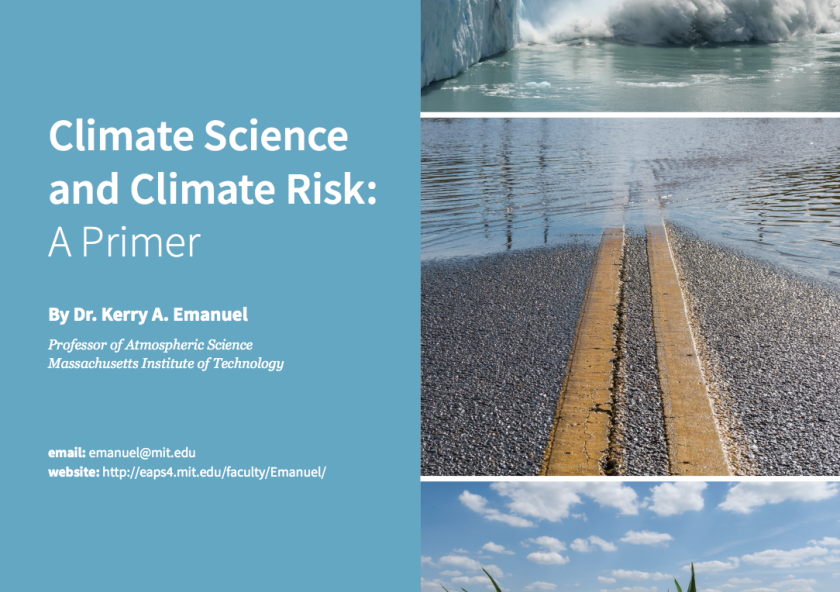
A primer for understanding climate science

Climate science and threats from climate change have been hot topics of conversation amongst the public as well as business and political leaders. And despite the fact that more than 90 percent of climate scientists attribute the majority of global mean temperature increase over the last few decades to human activity and warn that continued warming poses risks for mankind, doubt and misconceptions remain pervasive. This ultimately hampers efforts to improve the scientific field around climate and to develop effective solutions and policies to mitigate risks.
Now, a primer from Kerry Emanuel, climate scientist and hurricane expert in the Department of Earth, Atmospheric and Planetary Sciences’ (EAPS) Program in Atmospheres, Oceans and Climate (PAOC), explains how climate metrics and dynamics are evaluated, and why climate action today is important for our future. Addressing some common questions about the field of study, Emanuel summarizes evidence for anthropogenic climate change, confronts some of the stickier questions behind uncertainty in climate projections, and discusses particular risks entailed by climate change and how they are quantified.
Emanuel worked with Larry Linden, an MIT alum and president of the Linden Trust, on how best to structure the scientific information and provide a socioeconomic case for climate action. Using accessible language, they decided to write it for an audience of intelligent nonscientists who want to learn more about the science.
“What he’s [Linden] really trying to do is to get business leaders in particular, and some political leaders like moderate republicans to advance this issue,” Emanuel says. “Larry thought it would be handy to have a climate primer to help people like these get the background they need to persuade others.”
Beginning with an overview of the scientific process, the primer provides a short history of climate science through the years and shows how carbon dioxide, a small molecule that makes up about 0.04 percent of the atmosphere by mass, could be responsible for Earth’s changing climate. Emanuel points to the greenhouse effect, trends in global mean temperature over Earth’s history, and the mechanisms underlying past climate change. He shows how evidence of certain weather patterns, ice, and ocean extent can be seen in the geologic record and ice cores, indicating past climate conditions, and explains how variables like changing sunlight and orbit cannot account for Earth’s recent, rapid warming.
While the past can help us understand paleoclimates and Earth cycles under certain conditions, it can only hint at what the future climate may look like. But technology helps narrow down the possibilities. The primer includes a discussion of climate models, their abilities and limitations, and how they are used to predict future climate change in the context of human activity. Lastly, the primer assesses direct risks from climate change to the United States like sea level rise, destabilization of food and water supplies, ocean acidification, and more strong storms, and acknowledges indirect risks like human conflict, immigration, and geopolitical destabilization. Emanuel explores how various levels of carbon dioxide emissions management and policy can mitigate some of the more damaging and costly outcomes of climate change.
“I want people to understand that the basic physics of climate have been known for well over 100 years, and to make the point that much of what we know about the climate system is based on simple physics and not as much on huge, complicated models that are often cited as the main basis for concern about climate,” Emanuel says. “I try to lay out in a simple and compact way the evidence that we are incurring substantial risk, and to talk quantitatively about what the risks are.”
But Emanuel didn’t want to his primer to be a picture wholly of doom and gloom, as that is not accurate, nor the best way to motivate action.
“Right now there’s a huge swath of people that believe that to solve this problem, we have to pay through the nose. … I don’t think they really understand the full range of options: what is new and exciting on the energy front and what the solutions really could be,” Emanuel says. By painting a legitimately optimistic picture about viable climate and energy solutions, he thinks pessimism about the outcomes and resistance to the science fades away. And the strategy to get that to happen, he says, “may not involve that much climate science.”
“The object at this point in history is not so much to persuade people that we climate scientists are right as to persuade them that decarbonizing is in their own economic as well as environmental interest, and that the future of energy, far from being gloomy, is in fact very exciting,” he says.

